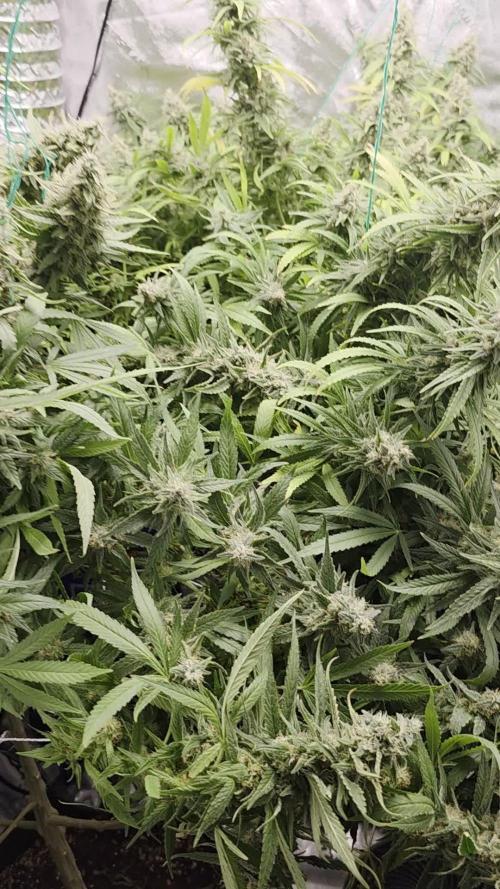The Grow Awards 2026 🏆 





























Likes
Comments
Share


@4chuk
Follow
When I began the contest I had only grown Magic Melon once before (last winter), it grew in an 18 litre pot, became around 4 feet tall, and completely filled a 3'x3' tent. A friend of mine successfully grew a seed I gave them this summer in a container about 4 litres and the plant was considerably smaller. The fact that it can be successfully grown in less than 250mL is astonishing, I have buds from the one grown last winter that are bigger than the can I grew this one in.
Harvested 91 days from sprout.
Likes
80
Share


@Greenwolvesfarmer
Follow
Me impresiona su forma híbrida , sus hojas están preciosas ! Y su vista desde arriba realmente parece una "X" ... A esta nena se le hará el mismo tratamiento que a mi querida lemonking ... Todo bien por el momento su espacio internodal anda de lujo ! Bella a tu espera !!
.
.
.
#lemonshiningsilverhaze #royalqueenseeds #greenwolvesfarmer
Likes
35
Share


@TheBudWhisperer
Follow
Finishing out at a full 9 weeks of flower for the rest of this cycle. All of em are at various stages of doneness and now nothing left to do but chop em up and see what we got. It was a generally flawless run, save issues with WPM, a bit of nute burn on the northern lights and one leaky pot. The seals cracked on all of em again and we’ll mod the outlets to uniseals next run and see if that is the final missing piece to this hydroponics puzzle😎. The 5ml/L baking soda solution did wonders to keep the WPM in check and it’s also a much cheaper option than h2o2. We’ll draw about 1/2oz per plant when alls said and done - pretty much exactly what we were trying for with this grow of clones. Nothing but top shelf, rock hard bud🤟👍. Really happy to get these strains dialed in. The nutrient system was nothing short of phenomenal too. We could’ve jumped on the nute burn issue with the NL a little earlier but for a first run of this one component system, this is a fantastic result regardless. Proof that you can get a hydro run to scale on a recirculating system that accommodates multiple strains (with the right nute system)🤩🤩🤩.
As much as I’m dying to give the whole thing a go with straight fem seeds that’ll have to wait a couple months. We’ve got bigger fish to fry and a new cross to start drilling down on. The layover may be short lived if we end up with multiple fem cuts on that grow. We’ll see what happens. Harvest details will follow shortly and until the next one - thanks to everyone who stopped in for a look👊.
Likes
35
Share


@IndicaVibeMe
Follow
It was amazing this week!!! Today my girls finally arrived!!!! ROYAL DWARF was put direct in the soil. 1x Critical was put in micro cup w/peat moss.
Shogun, Triple G & PurpleQueen👑 in H2O . Now we wait 😈
Likes
15
Share


@GrowsHimself
Follow
Happy with the amber percentage so chopped her down today 17/01/24. Some quick trimming of biggest fan leaves and then into dryer before it’s full dry trim.
Final dry weight after trim 116.8g
Likes
20
Share


@Boomdrawfyah
Follow
Dia 126, 5a semana de floración se ven muy sanas y estan empezando a formarse los cogollos, la floración va un poco lenta, se puede ver la 1051 y la Chocolate Wafflez ya estan llenas de resina , la Glow Starz y la White Noise siguen generando cogollo, hemos visto algunas orugas que nos han sorprendido ya que no han habido lluvias todavia y las plantas estaban protegidas, pero supongo que las bajas temperaturas generan las orugas
Likes
11
Share


@4_Pro2Bono_0
Follow
Decided to let these ladies get one more week before I flip, wish me luck 🤞
Likes
35
Share


@Nor_Cal_Kannabliss
Follow
Welp, These took a Bit longer than my Cream Cookies and still didn't fill out quite like I thought they would.. But they are still a very beautiful strain and a joy to have grown. They smell stronger and way more lovely than the cream cookies thou just a beautiful aroma
I'd really like to grow these again Indoors where I can control them easier. (Sadly they dried into wispy nothings and we turned them all into bubble hash)
#3 took the hit of some aphids and ended up in a frozen hash pile in our fridge along with two cream cookies from the run. It's frozen weight combined was 203g. *will update with dry*
Likes
3
Share


@Ninjabuds
Follow
7I wish they didn't make me do this to get a smileI wish they didn't make me do this to get a smileI wish they didn't make me do this to get a smileI wish they didn't make me do this to get a smileI wish they didn't make me do this to get a smileI wish they didn't make me do this to get a smileI wish they didn't make me do this to get a smileI wish they didn't make me do this to get a smileI wish they didn't make me do this to get a smileI wish they didn't make me do this to get a smileI wish they didn't make me do this to get a smileI wish they didn't make me do this to get a smile
Processing
Likes
26
Share


@Growin
Follow
Holaaa
Hoy día 43 desde la germinación retomamos el seguimiento a estás señoritas.
Altura Sweet gelato auto 81 CM
Altura Cmxl1 62 CM
Altura Cmxl2 60 CM
Hoy se realiza riesgo de 1 Lt , la Sweet gelato ha demostrado más signos de mayor requerimiento de agua, por lo que aumentarle la frecuencia de riego para esta planta.
Me sorprende que la Sweet gelato auto ha crecido lentamente, alcanzando una altura considerable de XL, y ahora que ha entrado en floracion, se siente ese gran aroma dulce.
Comienza la cuenta regresiva para las Cream Mandarine, cada día se aprecian mayor tamaño de las flores .
Día 45.
Riego con 1 Lt por planta
Día 47
Altura Sweet gelato auto 89 CM
Altura Cmxl1 67
Altura Cmxl2 60
Dia 48
Riego 1Lt por planta
Aportes, sugerencias, favor comentar.
Likes
14
Share


@Cannabot
Follow
100% Germination rate for me on this grow.Looking forward to growing this legendary strain by Franco@ Greenhouse Seeds.Grown in south africa
Likes
11
Share


@4_Pro2Bono_0
Follow
Been a smooth week lots of nice growth. Topped one plant to let the others catch up a a bit. I'm top feeding and watering once a week as of right now.
Likes
5
Share


@keiffie97
Follow
So pictures were taken at the end of week 6 going into 7. My biggest complaint would be that I should have double trellised. These guys are huge. The colas are getting increasingly heavy. I've attempted to string up some of the cholas but its a fleeting attempt. The smell is insane. Its alot more fruity this week. A buddy mentioned he smelled peanut butter notes. I smell fron the small one heavy limes, deiselly, duke. The larger one is more sticky and has like a lemony pepperish fruit thing going on but either way im excited. I will cut down on cal mag and sturdy stalk these last weeks. I havnt done anything extreme with ph. I got some interesting color changes. A little concerned im confusing color changes for the plant leaves drying out but I haven't had any immediate concerns to change up anything. Almost there!
Likes
7
Share


@Krissci
Follow
Defoliated fan leave, week 2...
WC1 Has the strongest smell
WC2 is taller with greater internodal spacing
Likes
15
Share


@Dico29
Follow
week 6, i removed all the Internodes on the 5.5(I will mark the photos which is which) and lst on the 3 gallon pot(now four main colas).
Temperature is the current temp outside, I do it by day just cause.
There was a big storm and my plants loved it surprisingly, so tomorrow I’m going to drench the 3 gallon,which is dry again, in water to see if any more surge in growth happens.
3 gallon shows heavy prefñower I guess with pistils and the 5 gallon is alright


























